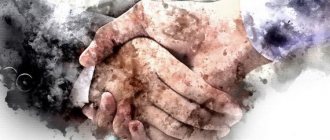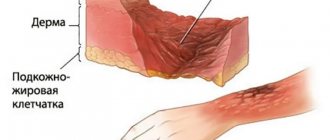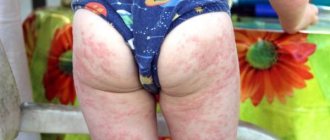Causes
In addition to pigments, hair dye contains alkalis, ammonia and other aggressive chemical components. Also, most paints contain an oxidizing agent, which is most often used peroxide. The highest content of the brightening component is in permanent permanent paints.
Due to the aggressiveness of the chemical composition, all hair dyes require attention and caution when used, however, ammonia dyes provoke the most severe skin irritation.
The most common cause of skin damage is failure to follow the manufacturer's instructions regarding dyeing time and dilution proportions (the paint must be diluted with an oxidizing agent before use).
Less commonly, a chemical burn to the scalp during dyeing occurs due to an allergy to the components contained in the composition, increased skin sensitivity, or the use of low-quality or expired products. In addition, some unscrupulous manufacturers do not always indicate on the packaging complete and reliable information about the components that make up the coloring product and their properties.
Usually, unpleasant consequences occur when you dye your hair yourself with dye purchased in a store. In beauty salons, as a rule, professional hair dyes are used, which have a milder effect on the skin and hair. Therefore, the risk of getting burned when dyeing your hair in a salon is much lower.
Composition and effect of hair dye
The bulk of coloring agents are chemical elements. They include:
- hydrogen peroxide - it is responsible for the oxidation reaction. Depending on the concentration of the component, the degree of effect on the hair differs. The minimum peroxide content is no more than 2%, which does not cause significant harm to the bulbs. A maximum concentration of 12% can cause irreparable harm to the hair structure;
- Ammonia is an aggressive and toxic substance that causes the unpleasant odor that comes from most paints. With frequent use, it makes hair weak and brittle;
- Oxidation pigment is what gives the hair the desired shade. If dyed incorrectly, it causes hair loss.
Composition of ammonia-free products:
- monoethanolamine - a component that replaces ammonia. It causes less damage to the hair, while the effect of the pigment is several times weaker, which does not always allow one to obtain the desired result;
- plant extracts;
- vitamins;
- oils;
- organics - honey, herbs, spices, berries.
Important! Do not mix ammonia-free paints with permanent ones.
Symptoms
A burn to the scalp after dyeing appears immediately. Its main symptoms are:
- pain, burning;
- severe redness;
- local increase in temperature;
- the formation of blisters filled with watery contents;
- the appearance of wounds, ulcers, erosions.
Depending on the depth of damage to the scalp, there are 3 degrees of chemical burns from paint.
- Superficial damage, accompanied by slight pain, burning, redness of the skin, itching and peeling.
- Involvement of deeper structures in pathological processes, manifested by cracking and peeling of the skin, the formation of wounds and blisters with watery liquid. Local symptoms may be supplemented by general manifestations of intoxication: headache, nausea, malaise.
- The spread of damage to all layers of the epidermis and dermis, characterized by severe pain, the formation of large blisters filled with bloody contents, and open oozing wounds on the skin.
In the classification of chemical burns, there is also a 4th degree of damage, in which the damage affects not only the skin, but also the subcutaneous tissue, muscle and nerve fibers. But it is virtually impossible to get a 4th degree burn from hair dye.
Differences from allergies
In addition to burns, the coloring composition can provoke an allergic reaction. With an allergy, unlike a burn, the integrity of the skin is not compromised. There is only redness of the skin, swelling, itching, peeling, and rash. General signs of allergies may also develop: nasal congestion and difficulty breathing, sneezing, watery eyes.
An allergic reaction can occur immediately or within 2 days after hair coloring. To prevent allergies from being complicated by eczema or hives, it is better to consult an allergist or dermatologist if alarming symptoms appear. The most severe manifestations of allergies requiring emergency medical care are angioedema and anaphylactic shock.
Signs of skin burn after hair coloring
You can distinguish a skin burn after unsuccessful dyeing, for example, from individual intolerance to the components of the composition, by a number of characteristic signs:
- redness;
- itching – varying degrees of intensity;
- burning;
- formation of blisters - immediately after a burn or after some time;
- swelling in the temporal area of the face and cheekbones;
- local hair loss;
- temperature increase;
- weakness;
- fever, chills;
- labored breathing;
- increased heart rate;
- nausea;
- vomit;
- dyspnea;
- increased blood pressure.
First aid
If burn symptoms occur while dyeing your hair, you should:
- wash off the aggressive composition from the hair;
- rinse your hair with running warm (but not hot) water;
- if the burning sensation is severe, apply a cool compress to the head (but not too cold);
- in case of severe pain, take any painkiller (Baralgin, Solpadein), consult a doctor;
- If you have difficulty breathing and other allergy symptoms, take an antihistamine (Cetrin, Zodak, Tavegil, Eden).
Risk of burns when dyeing hair
The consequences of an unsuccessful staining procedure depend on the degree of damage. For minor thermal or chemical burns, skin and hair can be restored with topical medications and anti-inflammatory drugs.
Mesotherapy and skin care procedures aimed at cleansing, exfoliating, and nourishing the skin are used as additional self-help.
For more serious damage, when the hair follicles are affected, their partial restoration is possible after a course of drug therapy prescribed by a trichologist.
Treatment
If a chemical burn of the scalp occurs during dyeing, treatment is carried out with local agents (ointments, creams, spray) based on dexpanthenol. This:
- Panthenol;
- Bepanten;
- Pantestin.
Medicines based on dexpanthenol have a cooling, moderate anti-inflammatory effect, relieve pain, moisturize, and stimulate the regeneration of damaged skin cells. The drugs are highly safe: they have virtually no contraindications, do not cause adverse reactions or allergies. The products are applied to the affected areas 2-3 times a day. Relief occurs after just a few procedures.
In addition to products containing dexpanthenol, the following drugs can be used for scalp burns:
- Olazol - a spray with benzocaine, boric acid, chloramphenicol and sea buckthorn oil quickly relieves pain, has an antiseptic and antibacterial effect, preventing infection of damaged tissues, promotes healing, applied to the damaged epidermis in a thin layer 1-4 times a day;
- Radevit - an ointment based on vitamins A (retinol), E (tocopherol), D2 (ergocalciferol) has an anti-inflammatory and regenerating effect, moisturizes and softens damaged tissue, reduces skin itching, used twice a day;
- Solcoseryl - the drug has a pronounced reparative effect, activates metabolic processes in damaged structures, stimulates their restoration, is available in the form of jelly and ointment, which is used to treat damaged skin 2-3 times a day.
In addition to the use of healing creams and ointments, solutions of Chlorhexidine and Furacilin are used. Gauze bandages soaked in them are applied to damaged skin in cases where open wounds and erosions form on the scalp after dyeing.
To avoid the development of an allergic reaction, the doctor prescribes antihistamines. Tavegil, Eden, Cetrin and other drugs in this group help reduce swelling and redness of the skin, itching, which invariably occurs during the healing of damaged tissue.
What to do urgently?
A burn to the scalp is a terrible and unpleasant occurrence, but there is no need to panic - you need to act decisively and quickly.
- First of all, you need to quickly wash off the paint, or remove boiling water when exposed to heat.
- A cooling bandage or a swab soaked in cold liquid should be applied to the injury.
- To prevent infection, the damaged area is treated with antiseptic compounds.
- If the damage occurred as a result of acid-containing compounds, they are neutralized with alkali (soap or soda composition).
- Damage by alkali, on the contrary, is neutralized with a weak solution of acetic or citric acid.
- Next, you should rinse your hair with cold, running water. It is strictly forbidden to use water if the burn occurred as a result of exposure to sulfuric acid or an organic aluminum compound. If you have a sunburn, give the patient plenty of fluids to drink.
Expert opinion
Zemlyanukhina Tatyana Vyacheslavovna
Ambulance and emergency paramedic at the Clinical Emergency Hospital #7 in Volgograd.
Ask an expert
For any burns, including chemical ones, be careful when using antiseptics. Under no circumstances should you wash an open wound with a concentrated alcohol solution, and certainly not experiment with acids and alkalis. There is a high probability that a reaction will occur that is not at all what was expected. In such cases, it is best to use antiseptics that do not contain active organic compounds, for example an aqueous solution of chlorhexidine.
Folk remedies
Drug treatment of hair dye burns can be supplemented with alternative therapy. Herbal decoctions help reduce inflammation and speed up the healing of damaged skin, and masks and oil compresses help restore the structure and healthy appearance of hair.
The most effective folk remedies that help cure burns from hair dye are:
- Chamomile and St. John's wort. Pour 2 tablespoons of herbs into a liter of boiling water, leave for 1 hour, strain. Rinse your hair with this infusion every day, do not rinse. The product helps relieve itching and inflammation, improve the appearance of hair.
- Sequence, mint, yarrow. Mix herbs in equal proportions. Pour 2 liters of water into 4 tablespoons of the mixture. Bring the mixture to a boil, cool, and dilute with another 2 liters of water. This hair rinse soothes and softens irritated skin, accelerates healing and strengthens hair. A decoction of sage, nettle and plantain, which is prepared and used in the same way, has a similar effect.
- Pumpkin oil and aloe juice. Mix 3 tablespoons of oil with 5 tablespoons of aloe juice. Apply the mixture to the scalp, rubbing lightly, and leave for half an hour. Wash off after half an hour with warm water using hypoallergenic baby shampoo.
- Almond and chamomile oil. Mix 2 tablespoons of almond oil and 1 tablespoon of chamomile oil, add the yolk. Heat the mixture in a water bath to 37-38° C, distribute evenly throughout the hair. After half an hour, rinse with warm running water.
Post-burn therapy
Treatment of chemical exposure may include both classical medications and folk remedies. It all depends on the severity of the burn.
Traditional treatment
The first and most necessary medications are those containing dexpanthenol, a B vitamin, a derivative of pantothenic acid. Such means include:
- cream and spray Panthenol,
- Bepanten cream,
- Pantestin ointment and cream.
They have anti-inflammatory, healing, cooling and antiseptic properties. The products help restore damaged tissues, prevent the penetration of pathogenic microorganisms, moisturize and nourish skin cells. Dexpanthenol is absolutely safe and hypoallergenic .
The following drugs have a similar effect:
- spray Olazol,
- Solcoseryl ointment,
- ointment Radevit.
These agents stimulate tissue regeneration, accelerating the process of division of healthy cells, activate local metabolism, disinfect damaged areas, and eliminate inflammation.
In addition to these ointments, solutions of Furacilin or Chlorhexidine are used to treat the consequences of a chemical burn. Bandages soaked in one of them are applied to the affected area in case of formation of cracks, wounds, ulcers, or diaper rash.
To eliminate possible allergic manifestations, the doctor prescribes antihistamines. They help relieve swelling, redness, and itching that appears as the skin heals. In extreme cases, surgery may be necessary to remove dead tissue.
Prevention
By taking precautions when coloring your hair, chemical burns to the scalp can be prevented. For this it is enough:
- use only high-quality paint, do not purchase products from unknown manufacturers, check expiration dates and integrity of packaging;
- do not purchase paint from markets where storage conditions are not met;
- if you are allergic to any chemicals, carefully check the paint composition for the presence of allergenic components;
- give preference to natural dyes (henna, basma, chamomile decoction, onion peel), paints that do not contain ammonia and peroxide, and tinted shampoos;
- follow the instructions for coloring: dilution proportions, exposure time of the coloring composition on the hair;
- do not dilute the paint in a metal container (the components of the paint composition and the oxidizing agent may react with the metal, which will lead to a change in the composition and properties of the paint);
- use paint immediately after dilution, do not store leftovers for later use;
- apply the composition only to the hair growth area, lubricate the skin around it with a rich cream or vegetable oil before dyeing;
- Before painting, carry out an allergy test - apply the composition to a small area of skin and observe the reaction: if burning, redness and other signs of irritation do not occur, you can start painting.
Choosing the right hair dye and following the instructions for use of the product will prevent damage to the scalp. If a burn does occur, it is important to correctly assess the degree of damage to the scalp. Mild irritation of the epidermis can be cured independently with the help of medications and folk remedies. If the burn is severe, you will need the help of a dermatologist or trichologist; a specialist will tell you how to treat the burn, restore hair and avoid complications.
How to prevent skin damage when dyeing
If you dye at home, there is a risk of skin damage. To eliminate negative consequences from the procedure, use the recommendations of professional stylists and hairdressers:
- trust only high-quality products - do not buy cheap and dubious brands. Give preference to professional lines for hair coloring and care;
- carefully read the composition - the fewer active chemical components, the better;
- do not increase the exposure time of the paint - keep the composition for as long as indicated on the package. Follow all manufacturer's recommendations;
- Conduct testing before starting the procedure. Even a high-quality composition may not suit you and cause allergies. Dab some paint onto the crook of your elbow. Look at the reaction. Signs of an allergy – redness, swelling, itching. If even one of these symptoms appears, do not use the composition on your hair;
- At least 24 hours must pass from the last wash to painting. This time is enough for the body to produce subcutaneous fat - a natural protective barrier. It minimizes the negative effects of the product on the hair and scalp.
After you wash off the paint, use skincare cosmetics - make a nourishing mask, apply a restoring balm. To avoid skin irritation, rinse your head with an infusion of medicinal chamomile, brewed in the proportion: a tablespoon per liter of boiling water. Keep in mind that chamomile can turn yellow on bleached hair.
How to avoid burns while dyeing
If the manufacturer of an expensive and popular brand promises that its paint is absolutely harmless, do not believe it. All dyes have a negative effect on the skin and hair. To make coloring safe and minimize the risk of burns, experts suggest using the following life hacks:
- panthenol - apply the spray before starting the procedure - it will not interfere with the dye working with your hair;
- aloe gel is a neutral product, absorbs quickly, protects well, does not weigh down or make the root zone of the hair greasy;
- professional products - serums, protectors, lotions - have a liquid consistency and are quickly applied. They are used both before and during dyeing. Such compositions are produced by many manufacturers specializing in high-quality cosmetics.











